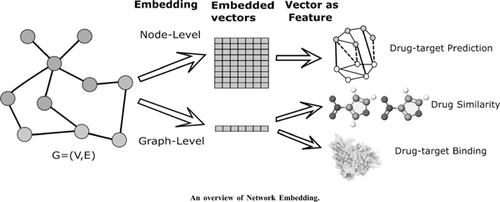Current Protein & Peptide Science ( IF 2.8 ) Pub Date : 2021-02-28 , DOI: 10.2174/1389203721666200702145701 Zhixian Liu 1 , Qingfeng Chen 2 , Wei Lan 2 , Jiahai Liang 3 , Yi-Ping Phoebe Chen 4 , Baoshan Chen 5

|
Traditional network-based computational methods have shown good results in drug analysis and prediction. However, these methods are time-consuming and lack universality, and it is difficult to exploit the auxiliary information of nodes and edges. Network embedding provides a promising way for alleviating the above problems by transforming the network into a low-dimensional space while preserving network structure and auxiliary information. This thus facilitates the application of machine learning algorithms for subsequent processing. Network embedding has been introduced into drug analysis and prediction in the last few years, and has shown superior performance over traditional methods. However, there is no systematic review of this issue. This article offers a comprehensive survey of the primary network embedding methods and their applications in drug analysis and prediction. The network embedding technologies applied in homogeneous network and heterogeneous network are investigated and compared, including matrix decomposition, random walk, and deep learning. Especially, the Graph neural network (GNN) methods in deep learning are highlighted. Furthermore, the applications of network embedding in drug similarity estimation, drug-target interaction prediction, adverse drug reactions prediction, protein function and therapeutic peptides prediction are discussed. Several future potential research directions are also discussed.
中文翻译:

用于药物分析和预测的网络嵌入调查
传统的基于网络的计算方法在药物分析和预测中显示出良好的效果。然而,这些方法耗时且缺乏通用性,并且难以利用节点和边缘的辅助信息。通过将网络转换为低维空间,同时保留网络结构和辅助信息,网络嵌入为缓解上述问题提供了一种有希望的方法。因此,这有利于将机器学习算法应用于后续处理。近年来,网络嵌入已被引入药物分析和预测中,并且已显示出优于传统方法的性能。但是,没有系统地审查此问题。本文提供了对主要网络嵌入方法及其在药物分析和预测中的应用的全面概述。研究并比较了均质网络和异构网络中应用的网络嵌入技术,包括矩阵分解,随机游走和深度学习。特别是,重点介绍了深度学习中的图神经网络(GNN)方法。此外,讨论了网络嵌入在药物相似性估计,药物-靶标相互作用预测,药物不良反应预测,蛋白质功能和治疗性肽预测中的应用。还讨论了一些未来的潜在研究方向。包括矩阵分解,随机游走和深度学习。特别是,重点介绍了深度学习中的图神经网络(GNN)方法。此外,讨论了网络嵌入在药物相似性估计,药物-靶标相互作用预测,药物不良反应预测,蛋白质功能和治疗性肽预测中的应用。还讨论了一些未来的潜在研究方向。包括矩阵分解,随机游走和深度学习。特别是,重点介绍了深度学习中的图神经网络(GNN)方法。此外,讨论了网络嵌入在药物相似性估计,药物-靶标相互作用预测,药物不良反应预测,蛋白质功能和治疗性肽预测中的应用。还讨论了一些未来的潜在研究方向。


























 京公网安备 11010802027423号
京公网安备 11010802027423号